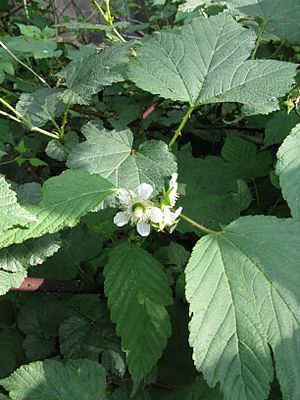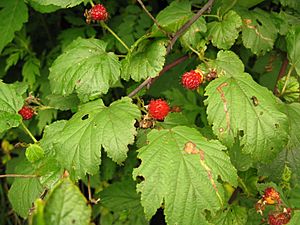Korean raspberry facts for kids
Quick facts for kids Korean raspberry |
|
|---|---|
 |
|
| May 2009, Japan | |
| Scientific classification | |
| Genus: |
Rubus
|
| Species: |
crataegifolius
|
The Korean raspberry, known scientifically as Rubus crataegifolius, is a type of raspberry plant. It grows naturally in East Asia, a region that includes countries like Japan and Korea. This plant is well-known for its delicious fruits, which look very similar to the raspberries you might see in stores.
What is the Korean Raspberry?
The Korean raspberry is a shrub, which means it's a woody plant smaller than a tree. It usually grows to be about 1 to 2 meters (3 to 6.5 feet) tall. Sometimes, it can even reach up to 3 meters (nearly 10 feet) high!
How Does It Look?
The leaves of the Korean raspberry are quite interesting. They are about 5 to 12 centimeters (2 to 5 inches) long and 5 to 8 centimeters (2 to 3 inches) wide. They have a special shape called "palmately lobed," meaning they look a bit like an open hand with three or five main parts. The edges of the leaves are also serrated, like a saw.
The flowers of this plant are small and pretty. Each flower is about 1 to 1.5 centimeters (half an inch) across. They have five white petals, which make them stand out against the green leaves.
The fruit is what most people are interested in! It's about 1 centimeter (less than half an inch) wide. Each fruit is made up of many tiny parts called drupelets, all joined together. This is why raspberries have that bumpy texture.
Where Does It Grow?
Korean raspberries like to grow in specific places. You can often find them on the edges of forests or on mountain slopes. They prefer areas where the soil is moist but also drains water well. This helps their roots get enough water without getting too soggy.
What Is It Used For?
The fruit of the Korean raspberry is very popular for eating. People enjoy its sweet and slightly tart taste. Sometimes, farmers even grow this plant on purpose. There's a special type, or cultivar, called 'Jingu Jengal' that was chosen because it grows really big fruits!
Scientists have also studied the roots of the Korean raspberry. They found that extracts from the roots contain substances that might help with swelling and pain. These are called anti-inflammatory effects. Researchers are still learning more about these potential health benefits.


